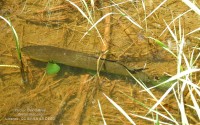Chocolate hind
(Cephalopholis boenak)

Image source: Rickard Zerpe | Wikipedia
Classification
General data
Cephalopholis boenak has a body which has a standard length which is 2.6–3.1 times its depth and with a head that is around a fifth of the standard length. Its dorsal fin contains 9 spines and 15–17 soft rays while the anal fin has 3 spines and 8 soft rays. The preopercle is rounded with fine serrations but no enlarged spines at its angle and with a flesh lower margin.
The body, including the abdomen, is covered in ctenoid scales which is a characteristic of this species. The overall colour is brownish to greenish-grey and there are normally 7–8 dark vertical bars on the flanks. The dorsal fin has a wide dark submarginal band and a thin white margin, these are also present on the anal fins, and the upper and lower lobes of the caudal fin. There is a blackish spot on the upper margin of the gill cover.
The juveniles have a yellowish on the posterior portion of their body and are marked with a white stripe which runs from the snout to the origin of the dorsal fin. It grows to a maximum total length of 30 centimetres (12 in).
Cephalopholis boenak has a wide distribution in the Indian Ocean and the Western Pacific Ocean from the eastern coast of Africa where it occurs from Kenya south to southern Mozambique along the southern Asian coast and into the Pacific where it occurs north as far as the Ryukyu Islands and east to New Caledonia. In Australia it has been recorded along the northern coast from Coral Bay, Western Australia to Moreton Bay in Queensland.








